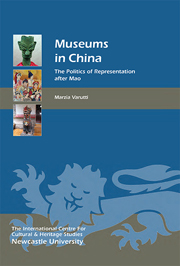Book contents
- Frontmatter
- Contents
- List of Illustrations
- Acknowledgments
- Chronology
- List of Abbreviations
- Introduction
- 1 Cultural Heritage in China
- 2 Museums in China: origins and Development
- 3 New Actors in the Chinese Museum World
- 4 Museum objects and the Chinese nation
- 5 The nation in the Museum
- 6 The Politics of the Past
- 7 The Representation of the Past in China's Museums
- 8 The Politics of identity
- 9 The Museum Representation of ethnic Minorities
- 10 Techniques and sites of Display of ethnic Minorities
- Conclusions: The new Museums of China
- Appendix: List of Museums in China Visited by the Author
- Bibliography and References
- Index
- Heritage Matters
1 - Cultural Heritage in China
Published online by Cambridge University Press: 05 March 2014
- Frontmatter
- Contents
- List of Illustrations
- Acknowledgments
- Chronology
- List of Abbreviations
- Introduction
- 1 Cultural Heritage in China
- 2 Museums in China: origins and Development
- 3 New Actors in the Chinese Museum World
- 4 Museum objects and the Chinese nation
- 5 The nation in the Museum
- 6 The Politics of the Past
- 7 The Representation of the Past in China's Museums
- 8 The Politics of identity
- 9 The Museum Representation of ethnic Minorities
- 10 Techniques and sites of Display of ethnic Minorities
- Conclusions: The new Museums of China
- Appendix: List of Museums in China Visited by the Author
- Bibliography and References
- Index
- Heritage Matters
Summary
This chapter considers the relevance of cultural heritage in Ancient and Imperial China, and its ties to political authority. An appreciation of the historical relationship between heritage and power in China is a useful preamble to the discussion of the forms that this same relationship takes in today's museums.
Heritage, Museums and Cultural Relics: Some Definitions
The concept of heritage is steeped in the specific cultural and historical trajectory of a country. As such, it cannot be transposed across different cultural contexts. It is therefore useful to recast the notion of heritage in light of its conceptualisation within the Chinese cultural milieu.
The term ‘heritage’ is translated in Mandarin by the word wenwu, encompassing both built heritage and objects, and bearing a historical connotation as ‘anything coming from the past’ (see also Chang 1999, 85). The Western meaning of heritage, which includes historical monuments, only appears in China after the end of the imperial era, when the process of identifying and cataloguing monuments began. However, a number of authors (Chang 1999; Zhang 2003) argue that the concept of heritage, understood as a corpus of historical monuments, does not have a direct equivalent within Chinese cultural tradition. In China, priority is not given to the physical aspect of historical buildings, but rather to their cultural-symbolic dimension. In other words, the cultural values that are transmitted through heritage are more important than their materiality. This is illustrated by the example of the Temple of Issei in Japan (Chang 1999, 81).
- Type
- Chapter
- Information
- Museums in ChinaThe Politics of Representation after Mao, pp. 9 - 24Publisher: Boydell & BrewerPrint publication year: 2014

